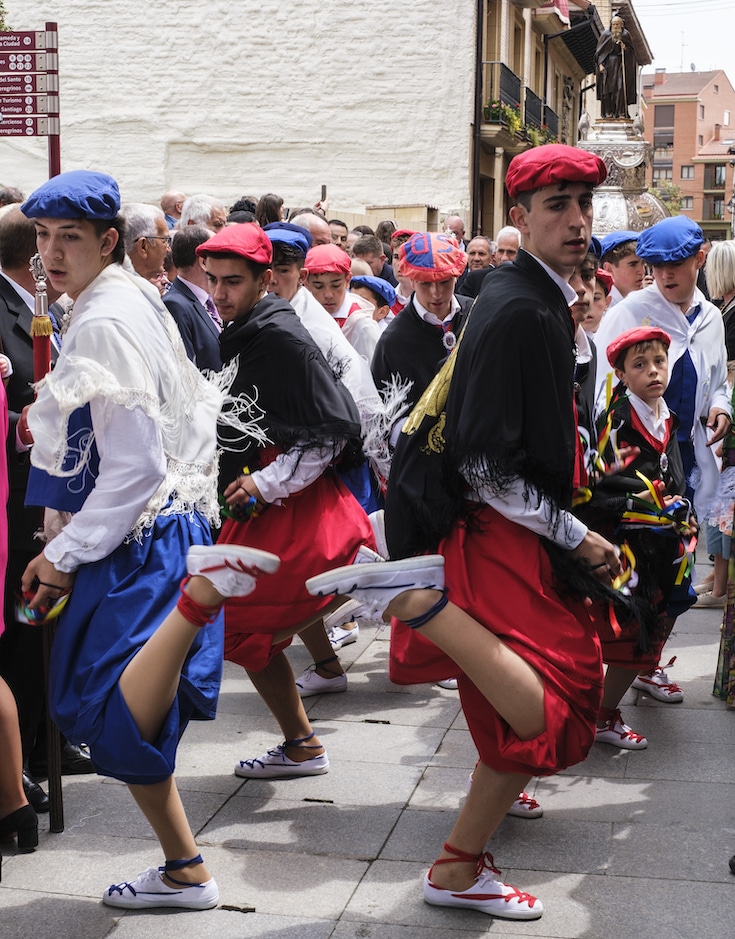
Young men in Santo Domingo de la Calzada dance in traditional costumes to honor Saint Dominic on May 12, the anniversary of his death in 1109. Photo by Charles Cecil
By Charles Cecil
It was pure good fortune that enabled me to arrive in Santo Domingo de la Calzada on the feast day of Saint Dominic, who died on May 12, 1109. I was hiking west along the Camino Frances, en route to Santiago de Compostela, when I arrived in Santo Domingo shortly before noon.
People were gathering in front of the cathedral for a procession that was about to begin. As I jockeyed for position, climbing atop a stone bench, the bishop emerged from the cathedral, accompanied by other church officials and a contingent of uniformed police and Guardia Civil. Behind them came a group of men carrying a religious statue of Saint Dominic on a small platform.
The streets were lined with spectators. Over the next hour the procession slowly wound its way through the streets of the old town. By racing around the block, away from the crowd, I managed to get ahead of the procession as it proceeded slowly along its route.
Immediately in front of Saint Dominic were a small number of municipal officials, some accompanied by their wives. Young men in medieval costumes performed traditional folk dances at points along the route. Young women in period dress marched together. Men wearing red berets played traditional melodies on flutes.
Though church attendance in Spain has been declining in recent years, participation in religious observations obviously still serves social, and perhaps political, needs.
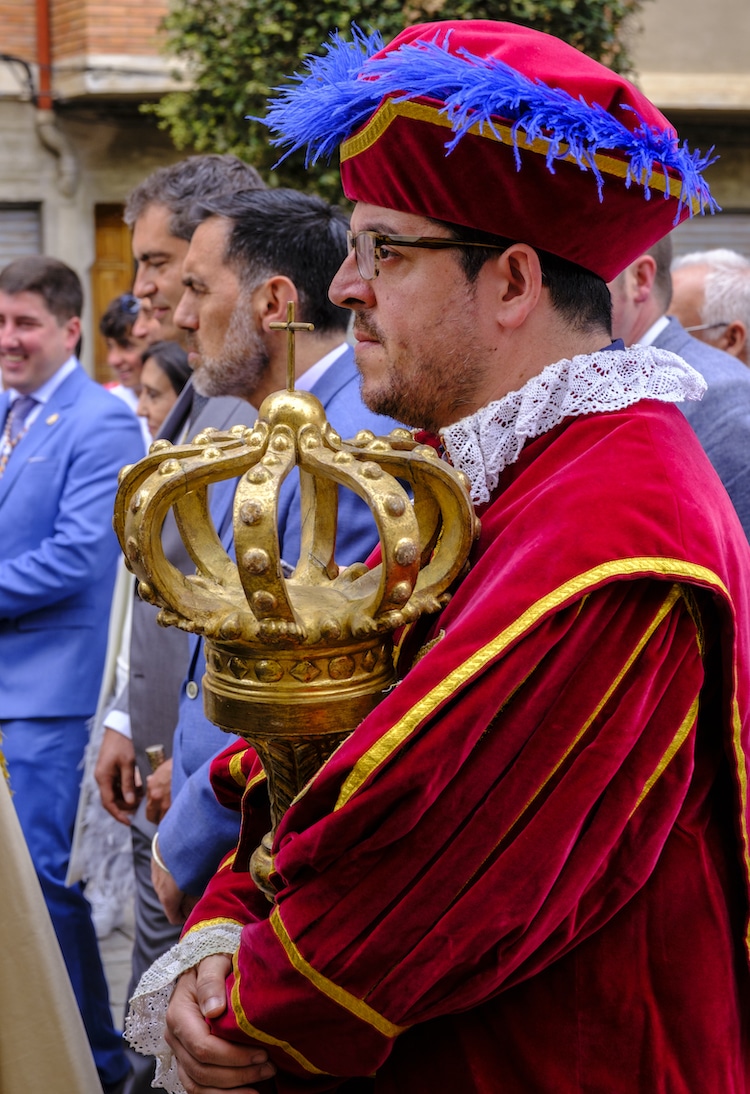
Municipal officials and church leaders in Santo Domingo de la Calzada lead a procession to honor Saint Dominic for his good works in the eleventh and twelfth centuries. Photo by Charles Cecil
Only the contemporary dress of the municipal officials, the police, and the spectators along the route marked this as a twenty-first-century event. The music and the dances were little changed from medieval times. I felt as if I were observing a cultural tableau dating back hundreds of years.
Saint Dominic became the patron saint of this town because of his good works in the eleventh and twelfth centuries, aiding pilgrims making their way westward to Santiago de Compostela, to the shrine reputed to hold the bones of Saint James (Santiago, in Spanish) the Apostle.
Dominic was born not far away in Burgos in 1019. Ordained a priest in 1039, he began to facilitate the travels of pilgrims by building a wooden bridge, later stone, over the river Oja. He then added a hospital and a hospice to help pilgrims, adding a paved causeway (calzada in Spanish) over a marshy area. People began to settle around the area, forming the core of what was to become Santo Domingo de la Calzada. Construction of a church was begun in 1090. Dominic died in 1109, but construction of the church continued and was elevated to the rank of cathedral in the 1230s. His remains are interred in the cathedral.
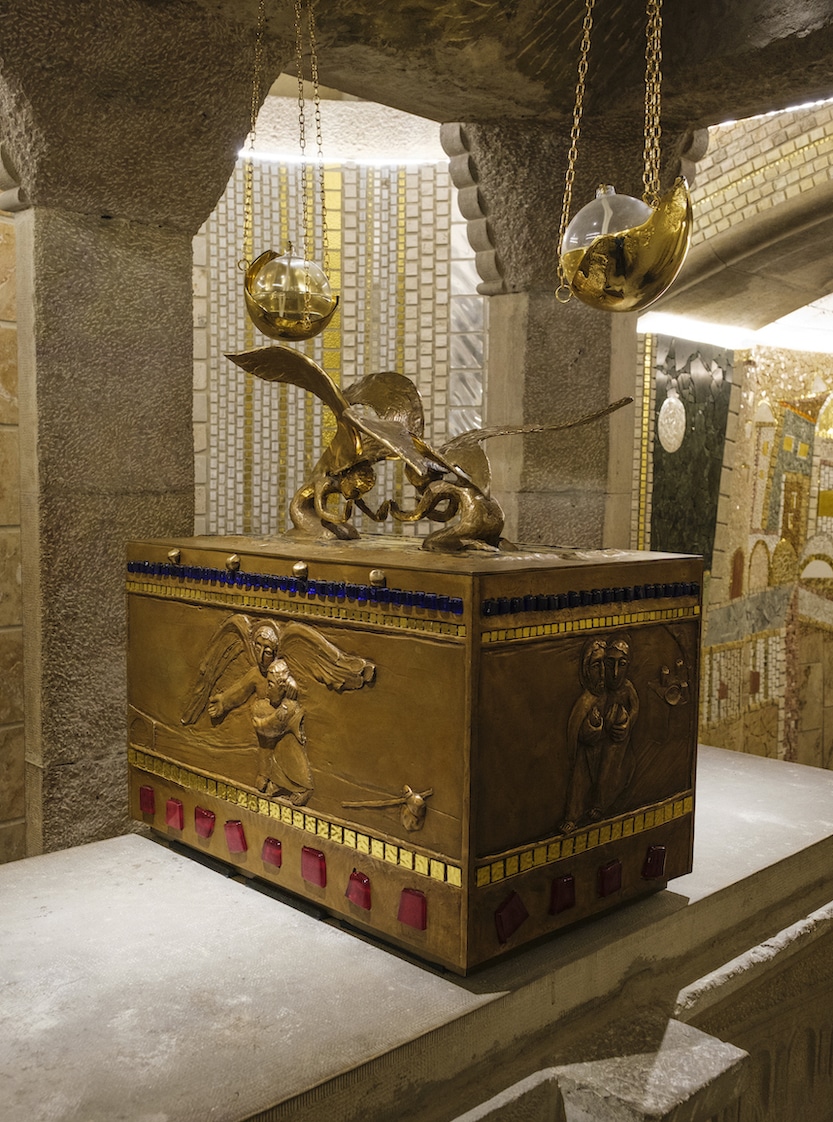
The Reliquary in the Cathedral of Santo Domingo de la Calzada contains the bones of Saint Dominic, the town’s patron saint. Photo by Charles Cecil
A miracle elevated the cathedral to greater prominence in the fourteenth century. According to legend, a German family including an 18-year-old son passed the night in Santo Domingo while en route to Santiago de Compostela. The son rejected sexual advances by the innkeeper’s daughter, who then hid a silver cup in the son’s pack and subsequently accused him of theft. The son was quickly tried, convicted, and hanged. But he did not die. As the boy dropped to his death, Catholics believe Saint Dominic magically appeared and held the teen tightly so the noose did not strangle him.
When the parents went to the local magistrate to request the release of their son the magistrate scoffed at them, saying that he would release their son as soon as the two roasted chickens on his dinner plate rose up and sang. Which is what they immediately did.
Today two white chickens, alleged to be descendants of the magistrate’s dinnertime birds, are kept in a coop inside the cathedral.
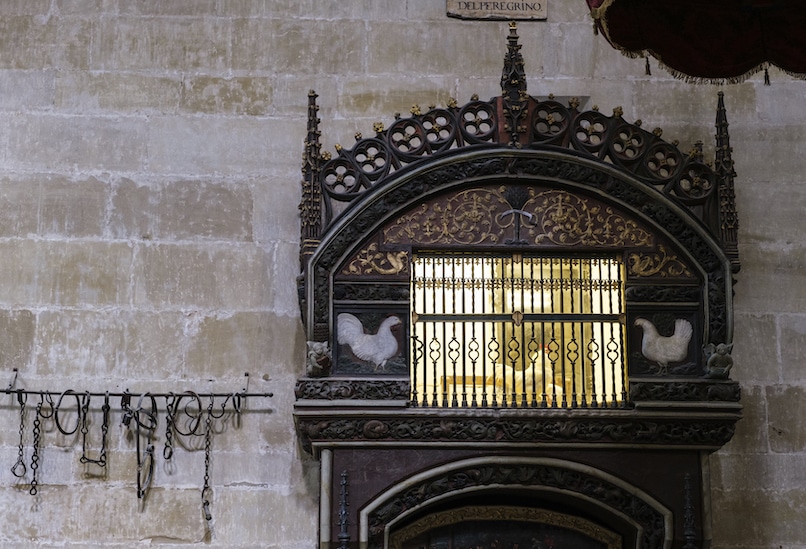
Descendants of the chickens that rose from the dead in the 14th century to save the life of an unjustly accused youth still inhabit the Cathedral of Santo Domingo de la Calzada. Medieval chains for restraining prisoners hang on the wall. Photo by Charles Cecil
These may be the two best fed birds in Spain, certainly the best cared for. But they share their good fortune with other chickens that are rotated in and out of the cathedral on a monthly basis.
Pastry shops in town sell chicken-shaped pastries called “milagros del santo” (“miracles of the saint”) in commemoration of the miracle. For his work on roads and bridges, Saint Dominic is now honored as the patron saint of civil engineers.
This is just the first of several destinations of religious interest along the Camino Frances, the name given to the trail followed by the majority of pilgrims across northern Spain. Several churches and cathedrals claim to hold relics of high spiritual value to pilgrims.
If timing does not allow you to be in Santo Domingo de la Calzada in May you have a second opportunity nearby in the village of San Juan de Ortega. San Juan assisted Dominic in his work in this region. His remains are in a sarcophagus in the San Nicolas de Bari church in the village bearing San Juan’s name.
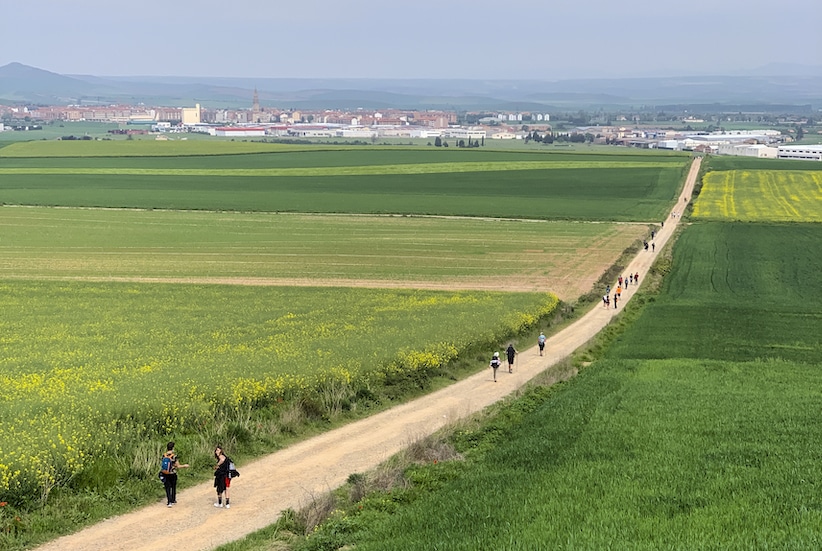
Pilgrims walking on the Camino de Santiago toward Santo Domingo de la Calzada. Photo by Charles Cecil
A pilgrimage procession is held in honor of San Juan the first Saturday in June by marchers bearing banners representing various nearby towns. Festivities also feature a fair and a market. Santiago’s feast day is July 25. Many try to time their walk so as to be in Santiago de Compostela for the celebratory mass. Six masses are held during the day, with the solemn mass at 12:30, usually presided over by the archbishop of Santiago. Go early. The cathedral will be packed, whatever time you choose.
As you proceed westward toward Santiago de Compostela you will pass other sites honored by Christian believers. At O Cebreiro the church of Santa Maria la Real contains a reliquary purported to hold the blood and flesh of Christ, which materialized miraculously in the hands of a thirteenth-century priest.
Pilgrims have been traveling on this and other routes since medieval times. The first guidebook to the route, the Codex Calixtinus, dates from the 12th century. The main destination is the cathedral of Santiago de Compostela, which contains the relics most highly revered by pilgrims. They supposedly include bones of the Apostle Saint James that were discovered in northern Spain in the ninth century.
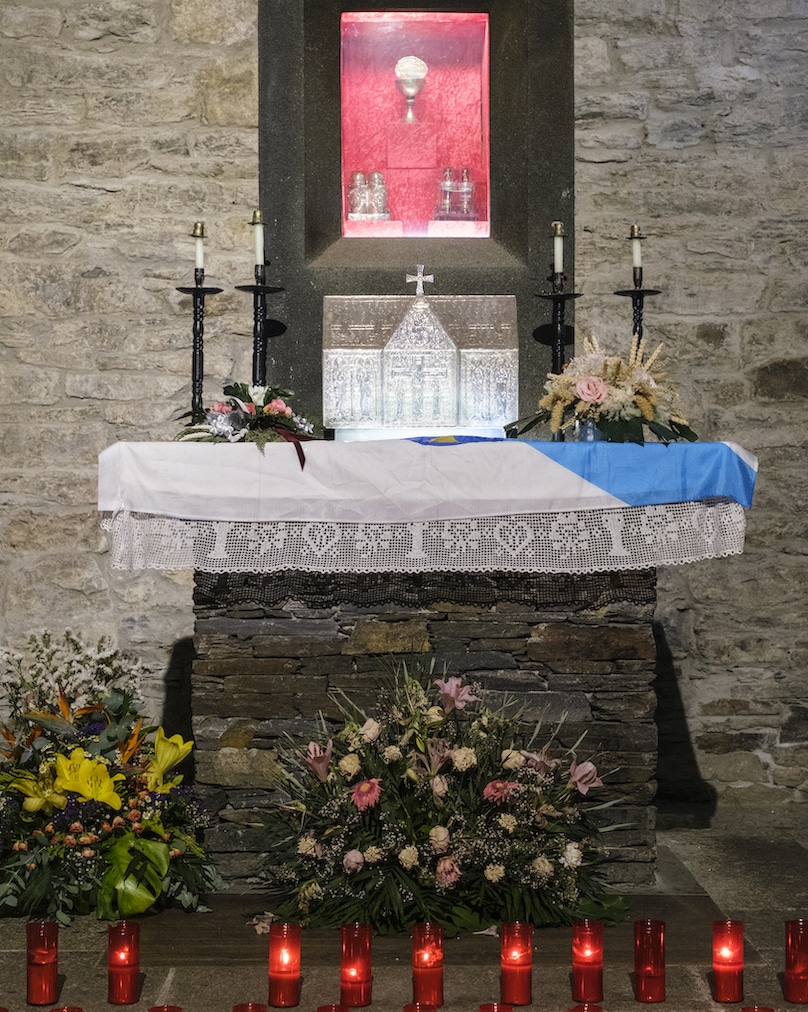
The town of O Cebreiro on the Camino de Santiago is home to the Church of Santa Maria la Real. Inside the church there is a reliquary that contains the blood and flesh of Jesus Christ, according to local Catholics. Photo by Charles Cecil
The legend of Saint James resides in faith, legend, and mystery, appropriate to his status as the patron saint of Spain. There are in fact no historical documents attesting to his presence in Spain.
The Acts of the Apostles, chapter 12, verse 2, identifies James as the first of the apostles to be martyred, probably in AD 44. Before his death legends assert he spent several years in Iberia spreading the gospel before returning to Judea and his death.
Some Spanish Catholics believe the Virgin Mary appeared to James in 40 AD while he was preaching the Gospel in Spain, and that after that meeting he returned to the Holy Land where he was beheaded. According to religious lore, James’ body was transported back to Spain in a stone boat, after which he was buried on a hill in Galicia.
The gravesite appears to have been forgotten over the course of the next eight centuries. But around 814 AD a hermit was led by a field of stars (“Compostela”) to the gravesite, where bones were discovered. A chapel was constructed over the site. King Alfonso II bestowed royal favor on the legend by making a pilgrimage to the site sometime after 818. By the next century, pilgrims began to come from outside Iberia as the legend gained wider circulation. Construction of the present cathedral began in 1075.
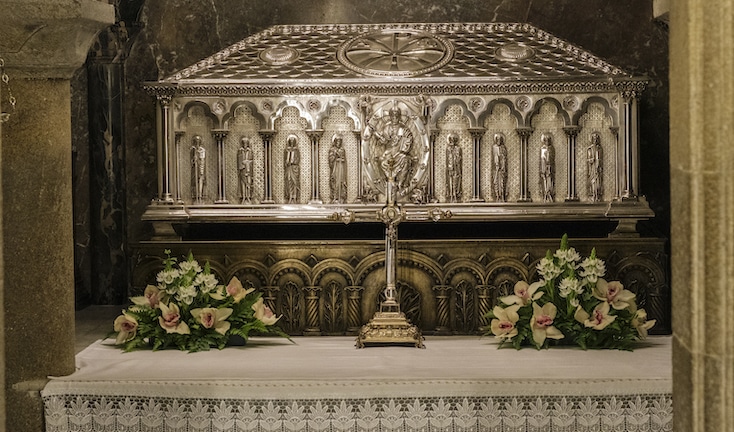
Reliquary purported to contain the bones of Saint James the Apostle. The Cathedral of Santiago de Compostela, which houses the reliquary, attracts hundreds of thousands of Christian pilgrims each year. Photo by Charles Cecil
It’s important to remember that much of Spain was under Muslim rule from the initial invasion from North Africa in 711 until the final expulsion of the last Muslim ruler in 1492. Church leaders were anxious to defend the faith, and to find ways to encourage believers to strengthen their devotion. Monastic religious orders were established, relics of questionable authenticity were acquired, and accounts of miracles were circulated, all of which led to an increase in the numbers of pilgrims making their way to the cathedral housing the reputed remains of Saint James.
Many came from France, resulting in the route being named the Camino Frances. Pilgrims brought with them French and wider European tastes in art and architecture, greatly enriching the culture of northern Spain.
Hiking to Santiago de Compostela has become quite popular in recent years, following efforts to upgrade and promote the trail. These efforts were spearheaded by O Cebreiro’s parish priest, Elias Valiña Sampedro. Father Sampedro initiated the practice of painting bright yellow arrows to indicate the path and published the first modern Spanish guidebook to the path in 1984. Father Sampedro is buried inside Santa Maria la Real in O Cebreiro.
The 2010 movie, The Way, starring Martin Sheen contributed to the trek’s increased popularity. By 2019, more than 146,350 Spanish and 20,600 Americans obtained a Compostela, the certificate that rewards those who complete the required 100 km minimum from Sarria to Santiago de Compostela. If you start in Ponferrada and complete the journey by bicycle, 200 kilometers are necessary.
The hike’s popularity extends beyond the U.S. and Europe. Of the 347,578 pilgrims (51% of them women) who earned their certificate in 2019, nearly 19,500 were from Latin American countries. Brazil and Mexico led this category with 6,025 and 4,091 hikers respectively. Even Nicaragua contributed 46 pilgrims.
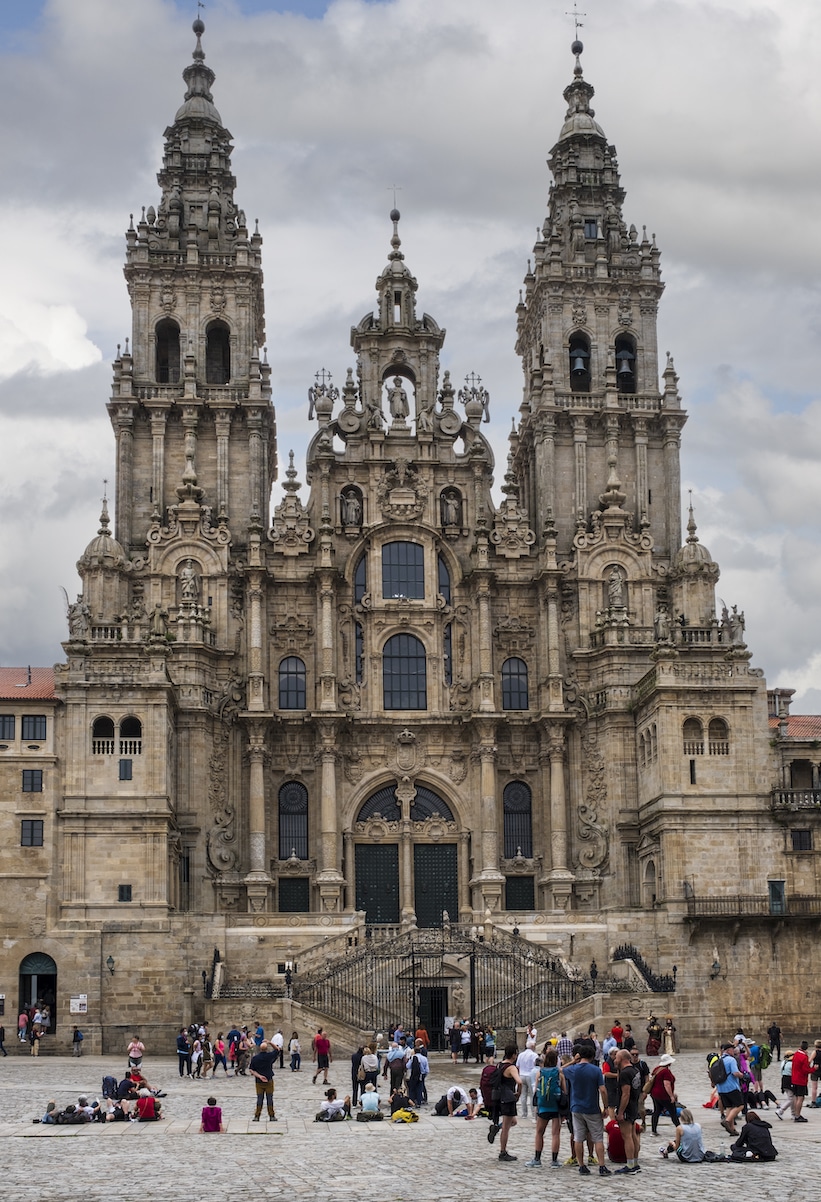
Pilgrims rest in the Plaza de Obradoiro in front of the West Facade of the Cathedral of Santiago de Compostela. Photo by Charles Cecil
Distance does not seem to dilute interest in the Camino. Nearly 14,000 pilgrims were from Asian countries, with Korea leading the way with 8,224, followed by 1,625 from Taiwan and 1,452 from Japan. Even 1,062 identified China as their country of origin.
Expectations are that 2022 will see a strong return to these pre-Covid figures.
It’s worth noting that these figures do not represent the total number of hikers along the trail. Many hike only segments and do not attempt to obtain the Compostela certificate. In addition, the lines of pilgrims at the office issuing the certificates can be very long and may discourage some hikers from waiting.
Religious faith motivates many of the pilgrims. Others simply want to experience Spanish food, scenery and personal contacts along the way. Some seek time alone to evaluate their lives, perhaps to set new goals and personal objectives. No matter what the motivation, a friendly camaraderie is shared along the path, with “Buen Camino” exchanged as walkers meet.
Whether you decide to do the whole thing—490 miles from Saint-Jean-Pied-de-Port on the Spanish-French border—or selected portions as I did, the experience is sure to leave you with a new perspective on life.
Former Ambassador Charles Cecil left the US Foreign Service after 36 years and 10 overseas postings to become a respected travel photographer. EWNS is proud to feature his photo essays on Bhutan and Senegal.

